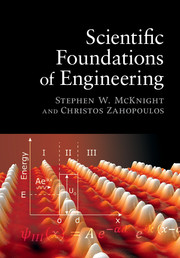Book contents
- Frontmatter
- Contents
- Introduction
- 1 Kinematics and vectors
- 2 Newton's Laws, energy, and momentum
- 3 Rotational motion
- 4 Rotation matrices
- 5 Materials properties: elasticity
- 6 Harmonic oscillation
- 7 Waves
- 8 The quantum puzzle
- 9 Quantum mechanics
- 10 Quantum electrons in atoms, molecules, and materials
- 11 Quantum electrons in solids
- 12 Thermal physics: energy, heat, and thermodynamics
- 13 Quantum statistics
- 14 Maxwell's equations and electromagnetism
- 15 Electromagnetic waves
- 16 Electromagnetic materials
- 17 Fluids
- Bibliography
- Index
Introduction
Published online by Cambridge University Press: 05 September 2015
- Frontmatter
- Contents
- Introduction
- 1 Kinematics and vectors
- 2 Newton's Laws, energy, and momentum
- 3 Rotational motion
- 4 Rotation matrices
- 5 Materials properties: elasticity
- 6 Harmonic oscillation
- 7 Waves
- 8 The quantum puzzle
- 9 Quantum mechanics
- 10 Quantum electrons in atoms, molecules, and materials
- 11 Quantum electrons in solids
- 12 Thermal physics: energy, heat, and thermodynamics
- 13 Quantum statistics
- 14 Maxwell's equations and electromagnetism
- 15 Electromagnetic waves
- 16 Electromagnetic materials
- 17 Fluids
- Bibliography
- Index
Summary
This book is based on notes prepared for a graduate course “Scientific Foundations of Engineering” in the Gordon Engineering Leadership Program at Northeastern University. The elevator speech on why such a course is needed goes as follows: (1) most engineering students take all of their basic science courses during freshman year, (2) they don't like those freshman courses very much, and (3) they forget the material as quickly as they can and concentrate on the specifics of electrical engineering, or mechanical engineering, or other engineering discipline where their interests and enthusiasm lies.
This summary may be unfair to some engineering students, but most engineering students (and their professors) at least grudgingly admit that it isn't terribly far off. And, in general, this approach serves the students well through their undergraduate education process and in their industrial careers – as long as they remain specialized in their specific engineering discipline. However, consider the case where an electrical engineer is leading a multidisciplinary project. One day a mechanical engineer who reports to her walks into her office and says, “Boss, this isn't going to work – we can't get the heat out!” A conventionally trained electrical engineer isn't likely to be able to frame a single substantive question about the problem. She hasn't studied heat transport or thermodynamics since the freshman year (if at all!), and likely has forgotten anything she ever knew about the subject. The ability to frame questions which put fundamental boundaries on the problem, “What is the power load? How hot will the device get? How much blackbody emission is there at that temperature? What is the thermal conductivity of the substrate?”, will not only enable an engineering leader to quickly frame the gravity of the problem, but will undoubtedly earn her a reputation as someone with whom you want to have done your homework carefully before making rash statements about engineering limits!
Science curricula often employ a “spiral curriculum” model. In physics for example, mechanics, thermal physics, and electromagnetics are surveyed in freshman year, revisited in specialized courses in sophomore or junior year, and often studied again from a quantum statistical viewpoint in a senior class. Engineering education more often selects a “breadth” coverage of the vast range of engineering applications, rather than the depth of understanding that the spiral curriculum seeks to impart.
- Type
- Chapter
- Information
- Scientific Foundations of Engineering , pp. 1 - 4Publisher: Cambridge University PressPrint publication year: 2015



